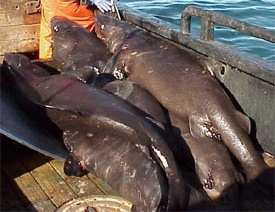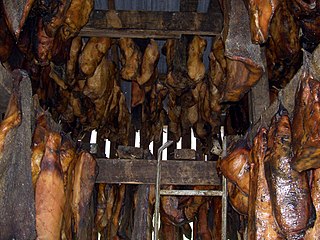Physeter is a genus of toothed whales. There is only one living species in this genus: the sperm whale. Some extremely poorly known fossil species have also been assigned to the same genus including Physeter antiquus from the Pliocene of France, and Physeter vetus from the Quaternary of the U.S. state of Georgia. Physeter vetus is very likely an invalid species, as the few teeth that were used to identify this species appear to be identical to those of another toothed whale, Orycterocetus quadratidens. The name is from Greek φυσητήρ (physētēr) 'blowpipe, blowhole .'

The Pacific sleeper shark is a sleeper shark of the family Somniosidae, found in the North Pacific on continental shelves and slopes in Arctic and temperate waters between latitudes 70°N and 22°N and in at least two places in the western tropical Pacific near Palau and the Solomon Islands, from the surface to 2,000 metres (6,600 ft) deep. The first evidence of the sharks in the western tropical Pacific emerged from a National Geographic video taken near the Solomon Islands in 2015. Its length is up to 4.4 m (14 ft), although it could possibly reach lengths in excess of 7 m (23 ft).

The Greenland shark, also known as the gurry shark, grey shark, or by the Kalaallisut name eqalussuaq, is a large shark of the family Somniosidae, closely related to the Pacific and southern sleeper sharks. The Greenland shark is a potentially important yet poorly studied cold-water species inhabiting the North Atlantic and Arctic Oceans.

Hákarl, referred to as fermented shark in English, is a national dish of Iceland consisting of Greenland shark or other sleeper shark that has been cured with a particular fermentation process and hung to dry for four to five months. It has a strong ammonia-rich smell and fishy taste, making hákarl an acquired taste.

Carcharhinus is the type genus of the family Carcharhinidae, the requiem sharks. One of 12 genera in its family, it contains over half of the species therein. It contains 35 extant and eight extinct species to date, with likely more species yet to be described.

The Somniosidae are a family of sharks in the order Squaliformes, commonly known as sleeper sharks. The common name "sleeper shark" comes from their slow swimming, low activity level, and perceived non-aggressive nature.

The little sleeper shark is a small sleeper shark of the family Somniosidae found in the northeast Atlantic, western Mediterranean, and western Pacific around New Zealand, at depths between 200 and 1,000 m. Its length is up to 1.43 m.

Somniosus is a widely distributed genus of deepwater dogfish sharks in the family Somniosidae. Several members of the genus are believed to attain lengths up to 7 m (23 ft), thus ranking among the largest of sharks.

Ailuravus is a genus of prehistoric rodents in the family Ischyromyidae.

Cycloderma is a genus of softshell turtles in the subfamily Cyclanorbinae of the family Trionychidae. The genus is endemic to Africa.

The southern sleeper shark or Whitley's sleeper shark is a deepwater benthopelagic sleeper shark of the family Somniosidae found in the southern Atlantic, Indian, Pacific, and Antarctic oceans.

The La Pedrera de Rúbies Formation is an Early Cretaceous (late Berriasian to early Barremian geologic formation in Catalonia, Spain. The formation crops out in the area of the Montsec in the Organyà Basin. At the La Pedrera de Meià locality, the formation consists of rhythmically laminated, lithographic limestones that formed in the distal areas of a large, shallow coastal lake. It is noted for the exceptional preservation of articulated small vertebrates and insects, similar to that of the Solnhofen Limestone.
The frog shark is a very rare species of squaliform shark mainly found in deep water in the Pacific Ocean. It is in the sleeper shark family Somniosidae with the Greenland shark.
Calathus gonzalezi is a species of ground beetle from the Platyninae subfamily that is endemic to the Canary Islands.
Agelena gonzalezi is a spider species in the family Agelenidae. It is endemic to the Canary Islands.

Colubroidea is a superfamily of snakes in the clade Colubroides that includes Colubridae, with some studies splitting Colubridae into multiple families that make up Colubroidea. Historically, Colubroidea also included other caenophidian snakes such as cobras and vipers, as these snakes form a clade. However these groups are now divided into several distinct, but related, families. Zaher et al. (2009) proposed to redefine Colubroidea for colubrids and related families, while designating Colubroides as the group containing vipers and cobras as well as colubroids. The ReptileDatabase considers Colubroidea to be composed of Colubridae and the members of its sister group, Elapoidea, and does not recognize the division of Colubridae into multiple families.
Acantholipan is a genus of herbivorous nodosaurid dinosaur from Mexico from the early Santonian age of the Late Cretaceous. It includes one species, Acantholipan gonzalezi.

Gomphurus gonzalezi, the Tamaulipan clubtail, is a species of clubtail in the family of dragonflies known as Gomphidae. It is found along the lower Rio Grande in the United States, and across the border into Mexico. It is known only in one state in the United States (Texas) and one state in Mexico.

Miocochilius is an extinct genus of small notoungulate mammals (typotheres) native to South America. The genus lived during the Middle Miocene epoch. The genus contains two described species, the type species M. anomopodus described in 1953 by Ruben Arthur Stirton and M. federicoi, described and included in the genus by Darin A. Croft.
The Taiwan sleeper shark is a small sleeper shark from the western North Pacific Ocean around Taiwan. It is only known from a single adult specimen, a 1.34 m (4.4 ft) pregnant female with 33 embryos, which was caught in 2017.












